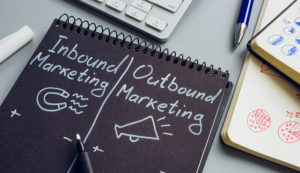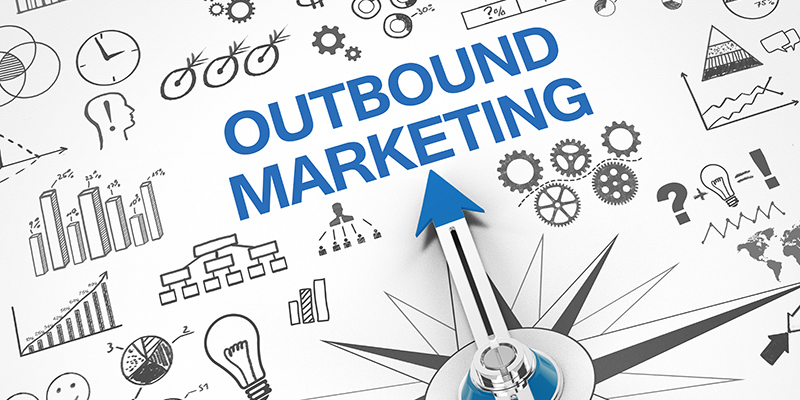A lot of marketers see outbound marketing as an outdated form of marketing. But, when used properly, it can yield great results.
What Is Outbound Marketing?
Outbound marketing is a form of marketing wherein the business is the one to initiate a conversation with its customers in an attempt to attract them. Prior to the age of social media and the Internet, outbound marketing was the norm. Today, many companies have largely shifted to inbound marketing, which is the exact opposite. Outbound marketing examples include cold calling or emailing, sending direct mail, advertising through TV, print, and radio, sponsoring events, and participating in tradeshows.
Inbound vs Outbound Marketing
 What is inbound marketing? Inbound marketing is a marketing strategy wherein a business attracts customers by creating valuable content and fostering a long-term relationship with them. The key difference between inbound and outbound marketing is the methodology for attracting customers. Inbound marketing focuses on the needs and wants of the customers, thereby drawing them to the company’s website. In contrast, outbound marketing involves the business proactively reaching out to customers through various means and getting them interested that way.
What is inbound marketing? Inbound marketing is a marketing strategy wherein a business attracts customers by creating valuable content and fostering a long-term relationship with them. The key difference between inbound and outbound marketing is the methodology for attracting customers. Inbound marketing focuses on the needs and wants of the customers, thereby drawing them to the company’s website. In contrast, outbound marketing involves the business proactively reaching out to customers through various means and getting them interested that way.
Is Outbound Marketing Still a Good Option?
Outbound marketing has long been the standard for businesses. Companies rely on an aggressive approach to spread their message. Because of the strategies involved, outbound marketing allows for a wider audience reach, even if a large chunk of that audience does not even fit the target. In fact, this marketing tactic has led to the creation of many blocking techniques, such as spam filters and TiVo.
As the technology evolved through the years, so did marketing strategies. Customers now spend most of their time online, skimming through search engines and following social media pages that specifically pique their interest. Because of this, businesses shifted to an inbound approach to marketing as it allows for a much deeper and long-lasting connection with customers, driving brand loyalty in the process.
But, that does not mean outbound marketing is completely useless today. On the contrary, it is a great way to increase brand awareness, preserve relevance, and introduce the brand to new customers. Maintaining a presence, whether online or offline, can cement a brand in the minds of customers and drive word-of-mouth marketing.
Essentially, outbound marketing promises reach, and you know that someone is on the other side. Although SEO is definitely an important tool in any company’s arsenal, running a TV ad during primetime guarantees visibility. Sure, it might cost more money, but it does give you something worthwhile in return.
Outbound Marketing Strategies to Use
Some marketers might see it as an outmoded form of marketing, but there are clearly still some merits to it. Here are some proven outbound marketing strategies businesses can use.
1. Cold Calls and Emails
Cold calling and cold-emailing are effective ways to reach out to a broader audience. Although these strategies get a bad rap, there are tips you can adopt to make cold calls and emails feel less unsolicited. Instead of using a pushy tone of voice, make it more personal and creative. For emails, go with a captivating subject line, offer valuable content, and use A/B testing. It also helps to make sure the email addresses you send to are active to reduce bounce rates.
As for cold calls, they can feel very intrusive, seemingly coming in at all the wrong times. But, for a lot of companies, cold calling works. To do it correctly, steer away from the sales scripts. As with emails, avoid adopting a pushy tone of voice. Instead, focus on engaging in meaningful conversations with customers. You should also look into targeting, as even the most convincing of sales calls won’t work if you’re not talking to the right audience.
Being respectful is also a huge part of cold calling and emailing. If someone asks to be taken off your email or call list, oblige. Don’t return with more emails and an even more aggressive sales pitch. This will only carve a bad reputation for your company in their minds. And, remember, word of mouth can spread quickly like wildfire.
2. Paid Search and Social Media Ads
 Print, TV, and radio ads are not the only ads that fall under outbound marketing. Paid search and social media ads may have started out as inbound, but they have increasingly evolved into outbound. After all, ads are something businesses use to get their brand and product in front of the eyes of customers.
Print, TV, and radio ads are not the only ads that fall under outbound marketing. Paid search and social media ads may have started out as inbound, but they have increasingly evolved into outbound. After all, ads are something businesses use to get their brand and product in front of the eyes of customers.
When creating your paid ads, make sure to go for clean designs and clear messages. Your landing pages should also look and feel in line with your brand’s voice and aesthetic. Apart from the appearance, landing pages should also run smoothly. That means no glitchy CTA buttons and ensuring your landing pages work well on mobile as well.
3. Direct Mail
People spend a ton of time plugged in that it can feel great to go offline every once in a while. Receiving direct mail is one way people maintain a connection outside of the confines of the Internet. In fact, sending direct mail to potential customers gets your company’s name out there. It also fosters trust in your audience and allows for a more personalized approach to marketing.
4. Trade shows and Events
While it is true that trade shows are becoming less and less common, there are still a number of them that draw in a lot of the right people. Trade shows are great because they put you in touch with your target audience, placing your brand directly in front of them (literally). This is also a good way to make connections and build relationships with other brands. Of course, setting up a booth at a trade show usually comes with a sizable upfront cost, not to mention the cost of having a booth made and printing out materials.
5. Traditional Media Ads
 A big reason why many businesses prefer inbound marketing is because it comes with a lower cost of entry than traditional paid ads like TV, print, and radio. But, traditional media still works, especially if you’re targeting an older audience. Younger generations might spend most of their time online, but older generations tend to stick to what they know — TV, magazines, and radio. If that’s your target audience, then you might benefit more from traditional ads than online ones.
A big reason why many businesses prefer inbound marketing is because it comes with a lower cost of entry than traditional paid ads like TV, print, and radio. But, traditional media still works, especially if you’re targeting an older audience. Younger generations might spend most of their time online, but older generations tend to stick to what they know — TV, magazines, and radio. If that’s your target audience, then you might benefit more from traditional ads than online ones.
Outbound Marketing Done Right
When executed properly, outbound marketing can be a powerful tool for any business. While some people might deem it obsolete, it is still a widely used strategy that can boost brand awareness and maintain a business’s relevance. When used in conjunction with inbound marketing, it can propel a company to great heights.
Tanner Grey is a full-service company offering web design and digital marketing services. Call us today at 844.500.1339 or contact us online to know more about how we can help you.
RELATED ARTICLES:
- What Is Branding? Online And Internet Representation
- What Is Influencer Marketing And How Can It Benefit Your Brand?
- Social Media For Small Business: Brand Visibility In The Social Scene







